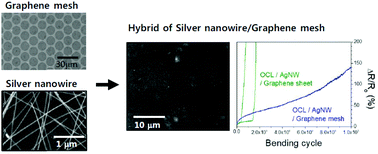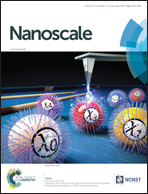A graphene mesh as a hybrid electrode for foldable devices†
Abstract
A graphene mesh with arrays of micro-holes was fabricated on a polymer substrate using photolithography for use as an electrode in flexible devices. The optimal mesh structure with high optical transmittance and electrical conductivity was designed using a finite element method, in which the conductivity of the mesh was simulated as a function of structure, size, and periodicity of the hole array. The sheet resistance of the graphene mesh was lowered to that of a graphene monolayer by chemical doping and found to be 330 Ω Sq−1 at 98.5% transparency. The figure of merit of the doped graphene mesh was calculated to be 106 at 98% transmittance, a value that has not yet been reported for any conventional transparent electrode material. Due to strong bonding between the polymer and substrate, the hybrid electrode composed of a silver nanowire (AgNW)/graphene mesh coated with an over-coating layer exhibited more stable electrical characteristics during mechanical fatigue deformation compared to a hybrid film composed of a AgNW/graphene sheet. The AgNW/graphene sheet underwent breakdown at less than 20 000 cycles in cyclic bending tests with 6.5% strain, but the AgNW/graphene mesh showed a 38% increase in resistance at 20 000 cycles and no breakdown even at 100 000 cycles. Therefore, in this study, we propose a hybrid structure composed of a AgNW/graphene mesh, which is optically and mechanically superior to AgNW/graphene sheets, and therefore suitable for application as a transparent electrode in foldable devices with long-term stability.

- This article is part of the themed collection: Graphene Turns 15: Bio-implications and Bio-applications


 Please wait while we load your content...
Please wait while we load your content...